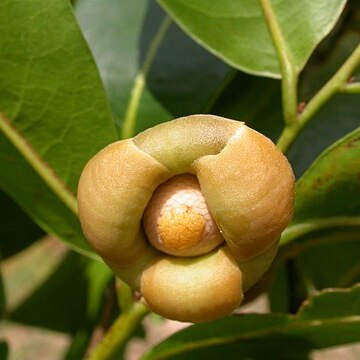Shrubs, climbing, sometimes erect or small trees, indument with stellate hairs. Inflorescences terminal, axillary, extra-axillary, leaf-opposed, or rarely on older branches; flowers mostly solitary or paired, rarely in short racemes or few-flowered cymes. Torus depressed, pubescent or tomentose. Sepals 3, valvate, usually connate at base. Petals 6, in 2 whorls, sometimes connate at very base, each whorl imbricate. Stamens many; anther locules often oblong or linear; connectives apically truncate to rounded. Carpels many, rarely few, linear-oblong; ovules many per carpel or rarely 2 or 3, in 1 or 2 series; styles outside often pilose; stigmas usually apically 2-cleft, involute. Fruit apocarpous; monocarps mostly ± stipitate, oblong, ovoid, or subglobose, fleshy and berrylike. Seeds several per monocarp or 1 by abortion, subhorizontal, with or without a short aril.
Woody stem-twining lianas or sometimes scandent shrubs, unarmed; nearly all parts bearing stellate or peltate indumentum. Flowers bisexual, mostly solitary or paired, rarely (not in Australia) in few-flowered cymes, terminal or leaf-opposed following growth of adjacent axillary shoot; pedicels with a medial bract. Sepals valvate at tips, connate. Petals 6 (–8) in 2 series, subequal, free or shortly connate at base; inner or both whorls imbricate in bud, usually spreading at anthesis. Stamens wedge-shaped or linear, sometimes outermost ones sterile; connectives short or elongate, papillate, concealing anther cells. Pollen grains solitary. Carpels numerous; ovules few-many; stigma secreting mucilage, horseshoe-or funnel-shaped with an adaxial slit. Apocarps mostly ellipsoidal or torulose, dry or succulent, indehiscent. Seeds few to many.
Stamens ?, the outer sometimes sterile and foliar, linear or obconic, with thecae lateral or extrorse and connective prolongations thin, tapering, rounded or truncate, rarely capitate; filaments very short or absent.
Carpels ?, free, linear or cylindric, with numerous ovules in 2 rows, rarely with 1–3 ovules; style very short or absent; stigma horse-shoe-shaped or funnel-shaped with a slit down the inner side.
Flowers usually bisexual, solitary or in few-flowered cymes, terminal or extra-axillary (often leaf-opposed), rarely on old branches, sessile or pedicellate.
Petals 6, in two whorls, both imbricate, equal or the outer whorl slightly longer, expanding and spreading at anthesis, free or rarely connate at the base.
Ripe carpels indehiscent, dry or succulent, often sweet and edible, globular to cylindric, usually on median or lateral stipes, many-to few-seeded.
Shrubs or small trees, usually climbing or scrambling, with stellate and sometimes also simple hairs.
Bracteoles 2, respectively basal and median or at the base of the calyx, often caducous.
Seeds horizontal or oblique; aril small, carunculoid.
Sepals 3, valvate, often ± connate.
Buds conic or ± globose.

